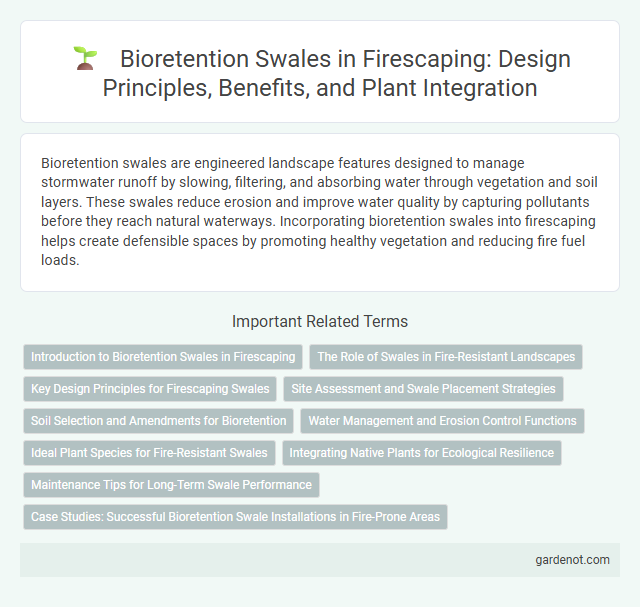Bioretention swales are engineered landscape features designed to manage stormwater runoff by slowing, filtering, and absorbing water through vegetation and soil layers. These swales reduce erosion and improve water quality by capturing pollutants before they reach natural waterways. Incorporating bioretention swales into firescaping helps create defensible spaces by promoting healthy vegetation and reducing fire fuel loads.
Introduction to Bioretention Swales in Firescaping
Bioretention swales play a crucial role in firescaping by effectively managing stormwater runoff and reducing fire hazards through strategic vegetation and soil filtration systems. These swales capture and filter water while supporting fire-resistant plants that minimize combustible materials near structures. Incorporating bioretention swales enhances landscape resilience against wildfires by promoting moisture retention and reducing fuel load.
The Role of Swales in Fire-Resistant Landscapes
Bioretention swales play a crucial role in fire-resistant landscapes by managing stormwater runoff while reducing fuel loads near structures. These vegetated channels promote moisture retention and support fire-resistant plant species, which help to slow fire spread and create defensible space. Properly designed swales enhance landscape resilience by integrating water management with wildfire risk reduction strategies.
Key Design Principles for Firescaping Swales
Bioretention swales designed for firescaping incorporate fire-resistant plants and non-flammable mulch to reduce wildfire fuel loads effectively. Proper grading ensures efficient stormwater management while minimizing potential fire pathways by directing water away from structures. Integrating native, drought-tolerant vegetation supports fire resilience and promotes ecological balance within the landscape.
Site Assessment and Swale Placement Strategies
Site assessment for bioretention swales involves evaluating soil permeability, slope gradient, and existing vegetation to ensure proper water infiltration and fire-resistant landscaping. Strategic swale placement targets areas with natural water flow, avoiding proximity to structures while enhancing moisture retention to reduce wildfire fuel loads. Properly located swales enhance fire resilience by creating defensible spaces and supporting fire-adapted plant species.
Soil Selection and Amendments for Bioretention
Soil selection for bioretention swales should prioritize well-draining loamy soils with a balanced mix of sand, silt, and clay to optimize infiltration and pollutant removal. Incorporating organic amendments such as compost enhances soil structure, increases nutrient retention, and supports microbial activity crucial for water treatment. Properly amended soils prevent compaction and facilitate healthy plant growth, improving the overall efficiency of the bioretention system in stormwater management.
Water Management and Erosion Control Functions
Bioretention swales effectively manage stormwater by capturing and filtering runoff, reducing peak flow rates and promoting groundwater recharge. Their vegetation and engineered soil layers enhance sediment retention and nutrient uptake, minimizing erosion and preventing pollutant transport. Integrating bioretention swales into firescaping landscapes improves water infiltration and stabilizes soil, mitigating erosion risks post-wildfire.
Ideal Plant Species for Fire-Resistant Swales
Ideal plant species for fire-resistant bioretention swales include native, low-flammability plants such as sedges, rushes, and certain succulents that retain high moisture content and exhibit minimal resin or oil production. Species like Carex spp., Juncus spp., and Salvia spp. offer effective erosion control while reducing fire risk due to their fire-resistant traits and capacity to thrive in wet swale conditions. Incorporating these plants enhances swale functionality by promoting water filtration and vegetation resilience in fire-prone landscapes.
Integrating Native Plants for Ecological Resilience
Bioretention swales designed with native plants enhance ecological resilience by promoting water infiltration, reducing soil erosion, and supporting local biodiversity. These native species are adapted to regional climate conditions, requiring less maintenance and increasing fire resistance compared to non-native alternatives. Integrating native vegetation within firescaping strategies helps create natural firebreaks while sustaining habitat connectivity.
Maintenance Tips for Long-Term Swale Performance
Regular inspection of bioretention swales ensures debris removal and prevents clogging, crucial for maintaining optimal water flow and filtration. Periodic vegetation management, including trimming and replanting native species, supports healthy root systems that enhance pollutant uptake and soil stabilization. Routine sediment removal and erosion repair preserve swale capacity, promoting effective stormwater treatment and long-term performance.
Case Studies: Successful Bioretention Swale Installations in Fire-Prone Areas
Case studies demonstrate that bioretention swales effectively manage stormwater while mitigating wildfire risks in fire-prone areas. Successful installations in California and Australia reveal that these systems enhance soil moisture retention, reducing ignition potential and promoting vegetation resilience. Research indicates that integrating native fire-resistant plants within swales further improves landscape stability and wildfire resistance.
Bioretention swale Infographic

 gardenot.com
gardenot.com